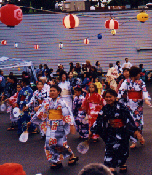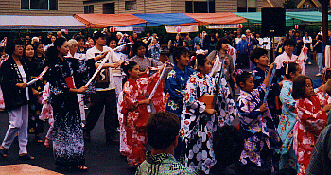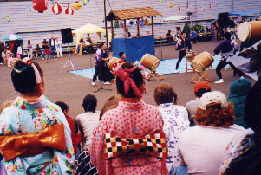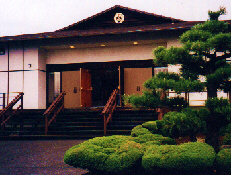Portland, Oregon, USA
Obon-fest '99
07 August 1999
 I associate
Obon, the Buddhist Festival of the Dead
with sweating, but I was shivering this rainy weekend in Portland
as I went to the the Oregon Buddhist Temple
to take in the local Obon events, held one week earlier than in Japan.
I associate
Obon, the Buddhist Festival of the Dead
with sweating, but I was shivering this rainy weekend in Portland
as I went to the the Oregon Buddhist Temple
to take in the local Obon events, held one week earlier than in Japan.
In the temple hall, the Buddhist reverend gave explanatory talks about the symbolism of chochin (paper lanterns), maneki neko (beckoning cat), incense, and Buddhist rosaries or "counting beads". By the temple altar, there was a chochin for each person in the congregation who had passed away during the past year. Reading the names and ages written on the chochin, it seems most had long and (one hopes) fulfilling lives -- the oldest lived to 107! In the basement and outside there were booths selling sushi, yakisoba, kakigouri (shave ice) and ... apple pie!
The people attending Obon-fest represented a full cross-section of the Nikkei community: issei (first generation) to rokusei (sixth generation), shin-ijuusha (post-War immigrants), intermarried couples, sojourners from Japanese companies and ryugakusei (Japanese students studying in U.S.). There were also many interested members of the general public, some of whom looked like they had spent time in Japan (they had their own yukata and knew the dances).
 The Oregon Buddhist Temple was established in 1903 by Japanese immigrants. During the World Fair held in Portland in 1905, craftsmen from Japan built temple's altar, the only one in America constructed in this country. The congregation uses two sets of okyou (sutra) books, one in Japanese and one in English. Sutras are recited in Japanese, so in the English book, the sutras are written in romaji (phonetic Japanese in Roman letters), but with no accompanying translation. The Japanese language has many homonyms (words with the same sound, but different meanings), so I had to open up the corresponding page in the Japanese book to see the specific kanji (Chinese ideogram characters) and thus figure out the intended meaning of the romaji. I wonder if the English-speaking Nikkei-jin are just chanting the sutras without knowing what they are saying? Faith should not be blind. |
| Discuss this topic on the Runker Room "Being Nikkei" Discussion Board |
Portland Mochitsuki 2000 | Portland Hanami 2000
View my guestbook | Sign my guestbook
 The periodic rain held off long enough to allow
Seattle Matsuri Taiko to play some songs (including
Yodanuchi, which I last heard played by
The periodic rain held off long enough to allow
Seattle Matsuri Taiko to play some songs (including
Yodanuchi, which I last heard played by

